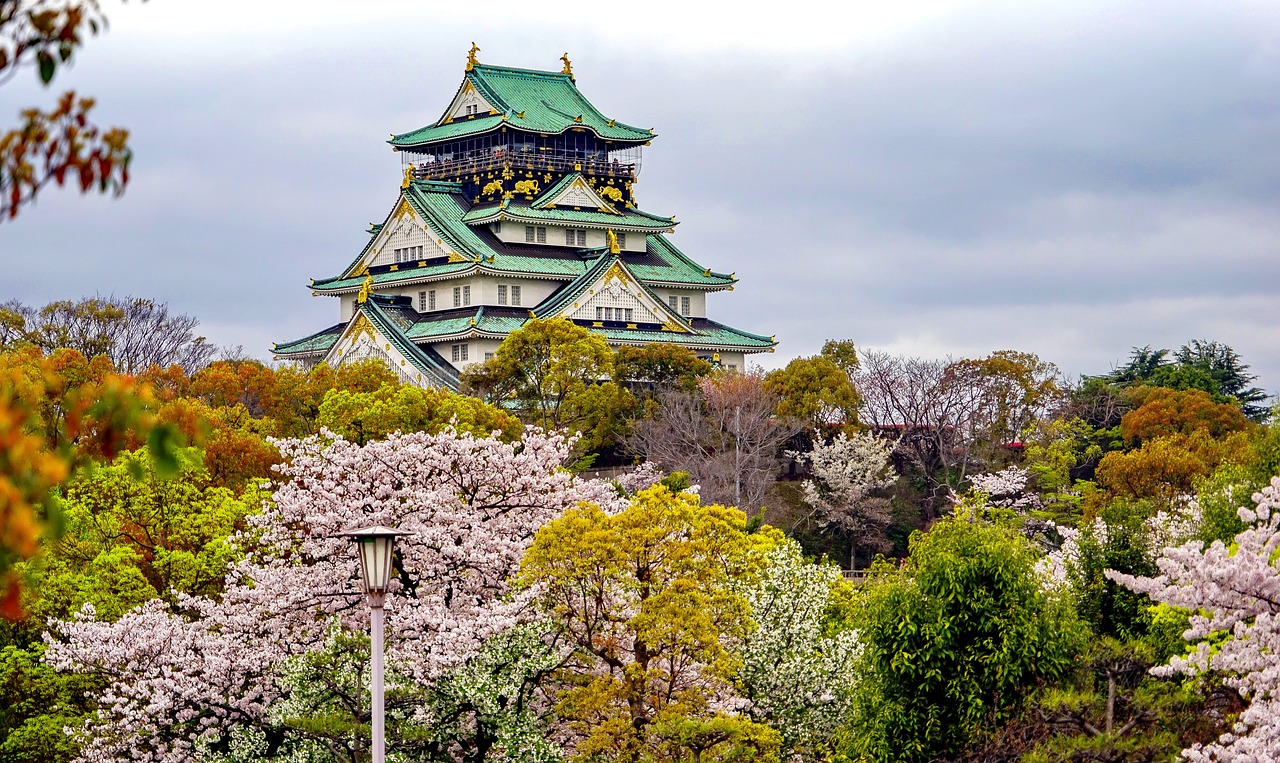こんにちは!今日は、英語の多読練習にぴったりな大阪の歴史についてお話しします。口語口調で簡単にまとめてみたので、気軽に読んでみてくださいね。
大阪の始まり
大阪は、古くから日本の重要な拠点として栄えてきました。古代には「難波(なにわ)」と呼ばれ、奈良時代には一時的に首都とされました。7世紀には、難波京が建設され、交易や文化の中心地となりました。
Osaka has long prospered as an important hub in Japan. In ancient times, it was called “Naniwa” and was temporarily the capital during the Nara period. In the 7th century, Naniwa-kyō was constructed, becoming a center of trade and culture.
中世には、港町としての役割が強まりました。室町時代には、堺という港町が繁栄し、商業と文化の交流が盛んに行われました。この時期、大阪は日本国内外との交易の拠点となり、多くの商人が集まりました。
In the medieval period, its role as a port town strengthened. During the Muromachi period, the port town of Sakai flourished, and commercial and cultural exchanges thrived. During this time, Osaka became a hub for trade both domestically and internationally, attracting many merchants.
安土桃山時代と大阪城
安土桃山時代には、織田信長や豊臣秀吉が大阪に目を向けました。1583年、豊臣秀吉は大阪城を築城し、大阪は政治と軍事の中心地となりました。大阪城は壮大な規模を誇り、多くの武将たちが集まりました。
During the Azuchi-Momoyama period, Oda Nobunaga and Toyotomi Hideyoshi turned their attention to Osaka. In 1583, Toyotomi Hideyoshi built Osaka Castle, making Osaka a political and military center. Osaka Castle boasted a grand scale and attracted many warlords.
豊臣秀吉の死後、大阪は徳川家康の手に渡り、大阪の陣(1614-1615)で激しい戦いが繰り広げられました。この戦いの結果、大阪城は破壊され、大阪は再び商業の中心地として再建されました。
After Toyotomi Hideyoshi’s death, Osaka fell into the hands of Tokugawa Ieyasu, and the fierce battles of the Siege of Osaka (1614-1615) took place. As a result of these battles, Osaka Castle was destroyed, and Osaka was rebuilt as a commercial center once again.
江戸時代の大阪
江戸時代には、大阪は「天下の台所」として知られ、商業と経済の中心地となりました。大阪には多くの商人が集まり、米や魚、織物などの取引が盛んに行われました。大坂三郷(大坂、船場、天満)と呼ばれる地域が発展し、多くの市場や商店が並びました。
During the Edo period, Osaka was known as the “nation’s kitchen” and became a center of commerce and economy. Many merchants gathered in Osaka, engaging in active trade of rice, fish, textiles, and more. The areas known as the Three Great Markets of Osaka (Osaka, Semba, and Tenma) developed, with many markets and shops lining the streets.
また、文化面でも発展を遂げました。歌舞伎や文楽(人形浄瑠璃)などの伝統芸能が盛んになり、多くの劇場が建設されました。学問や教育も発展し、町人文化が花開きました。
Culturally, Osaka also flourished. Traditional performing arts such as Kabuki and Bunraku (puppet theater) became popular, and many theaters were built. Education and scholarship developed, leading to the blossoming of merchant culture.
明治時代の発展
1868年の明治維新以降、大阪は工業都市として発展しました。近代化の波に乗り、鉄道や港湾施設が整備され、多くの工場が建設されました。大阪は日本の工業の中心地となり、多くの人々が仕事を求めて移り住みました。
After the Meiji Restoration in 1868, Osaka developed as an industrial city. Riding the wave of modernization, railways and port facilities were improved, and many factories were built. Osaka became the center of Japan’s industry, attracting many people seeking work.
また、大阪は商業の面でも発展を続けました。大阪商業会議所(現・大阪商工会議所)が設立され、多くの商人が集まりました。心斎橋や道頓堀などの繁華街も発展し、多くの人々が行き交いました。
Osaka also continued to develop commercially. The Osaka Chamber of Commerce (now the Osaka Chamber of Commerce and Industry) was established, attracting many merchants. Busy shopping districts like Shinsaibashi and Dotonbori developed, bustling with activity.
大正時代の繁栄
大正時代(1912-1926年)は、大阪がさらに繁栄した時期です。この時期には、近代的なビルや百貨店が次々と建設されました。大阪は日本の経済の中心地としての地位を確立し、多くの企業や銀行が本社を置きました。
The Taisho period (1912-1926) was a time of further prosperity for Osaka. During this period, modern buildings and department stores were constructed one after another. Osaka established its position as the economic center of Japan, with many companies and banks setting up their headquarters there.
また、文化面でも大阪は活気に満ちていました。映画やジャズ、カフェ文化が広まり、多くの若者が集まりました。大正時代の大阪は、経済的にも文化的にも豊かな都市として知られていました。
Culturally, Osaka was also vibrant. Movies, jazz, and cafe culture spread, attracting many young people. Taisho-period Osaka was known as a city rich in both economic and cultural aspects.
昭和時代の激動
昭和時代(1926-1989年)は、大阪にとって激動の時期でした。第二次世界大戦中、大阪は度重なる空襲に見舞われ、多くの建物が破壊されました。戦後、大阪は驚異的なスピードで復興し、再び繁栄を取り戻しました。
The Showa period (1926-1989) was a tumultuous time for Osaka. During World War II, Osaka was subjected to repeated air raids, and many buildings were destroyed. After the war, Osaka was rebuilt at an astonishing speed, regaining its prosperity.
戦後の復興期には、大阪万博(1970年)が開催され、大阪は国際的な注目を集めました。この万博は、日本の経済成長を象徴するイベントであり、大阪の都市としての地位をさらに高めました。
During the post-war reconstruction period, the Osaka Expo (1970) was held, attracting international attention. This expo symbolized Japan’s economic growth and further elevated Osaka’s status as a city.
現代の大阪
現在、大阪は日本の第二の都市として知られ、経済、文化、観光の中心地です。多くの観光客が訪れ、大阪城や道頓堀、ユニバーサル・スタジオ・ジャパンなどの観光地が人気です。大阪はまた、グルメの街としても有名で、たこ焼きやお好み焼き、串カツなどが楽しめます。
Today, Osaka is known as Japan’s second city, a center of economy, culture, and tourism. It attracts many tourists, with popular attractions such as Osaka Castle, Dotonbori, and Universal Studios Japan. Osaka is also famous for its cuisine, offering delights such as takoyaki, okonomiyaki, and kushikatsu.
大阪は常に進化し続けています。新しい技術やインフラの整備で、さらに便利で住みやすい都市になることが期待されています。最新の交通システムやスマートシティの取り組みなど、未来の都市づくりにも積極的に取り組んでいます。
Osaka is constantly evolving. With new technologies and infrastructure developments, it is expected to become an even more convenient and livable city. Osaka is actively working on future city-building, including the latest transportation systems and smart city initiatives.
大阪の未来
大阪はこれからも進化し続けるでしょう。新しい技術やイノベーションの導入により、都市の魅力がさらに高まることが期待されます。例えば、自動運転車やロボット技術の発展により、交通の効率性が向上し、生活の便利さが増します。
Osaka will continue to evolve in the future. With the introduction of new technologies and innovations, the city’s attractiveness is expected to increase even further. For example, advancements in autonomous vehicles and robotics will improve transportation efficiency and enhance convenience in daily life.
また、観光業や商業施設の拡充も見込まれます。大阪の魅力的な観光地やショッピングエリアがさらに発展し、国内外からの訪問者を引きつけるでしょう。これにより、地域経済の活性化や雇用の創出にも繋がることが期待されます。
Furthermore, there are expectations for the expansion of the tourism industry and commercial facilities. Osaka’s attractive tourist spots and shopping areas will further develop, attracting visitors from both domestic and international destinations. This will lead to the revitalization of the local economy and the creation of job opportunities.
大阪は多様性に富んだ文化や歴史を持つ都市です。この多様性を活かし、国際交流や文化交流の拠点としての役割も強化されるでしょう。外国人観光客や留学生が増加し、大阪の国際的な魅力がさらに高まることが期待されます。
Osaka is a city with diverse culture and rich history. Leveraging this diversity, it is expected to strengthen its role as a hub for international exchange and cultural interaction. With an increase in foreign tourists and international students, Osaka’s international appeal is expected to further enhance.
未来の大阪は、持続可能な都市開発や地域コミュニティの形成にも注力するでしょう。環境保護や地域社会の健全な発展を促進し、住民の生活の質を向上させる取り組みが行われることが期待されます。
Future Osaka will also focus on sustainable urban development and the formation of local communities. Efforts will be made to promote environmental protection and the healthy development of local communities, aiming to improve the quality of life for residents.
大阪の未来は明るいものであり、これからの発展が楽しみです。新たな挑戦とイノベーションにより、より魅力的で活気のある都市が築かれることでしょう。
The future of Osaka is bright, and we look forward to its continued development. Through new challenges and innovations, a more attractive and vibrant city will be built.

コメント